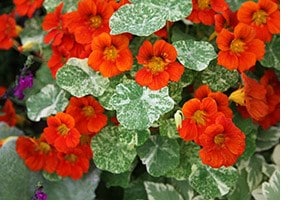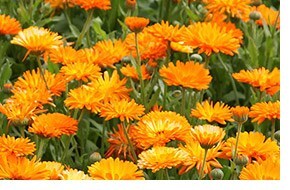Floral gastronomy

I used to be a bit sceptical about all this new-fangled fashion for eating flowers. All a bit Guardianista, I thought. Looks nice and all that, but what about the flavour?
 Well. Then I ate a rosemary flower. And found out about the flavour, and why people who eat flowers tend to eat rather a lot of them. I’m left with the feeling that for the last 20 years or so of my veg-growing life I’ve missed out on the best bit of my crop.
I now grow rocket not for the leaves but for the flowers: sweet, but with a peppery kick. Much nicer than the leaves, to be honest, so these days I don’t even bother with the salad course and go straight to the pretty bit. Radish flowers are pretty tasty, too (and followed by truly delicious green puffball seedpods).
And next time your brassicas bolt, try cutting the flower stems and eating them like a particularly colourful broccoli: this was all I got from the kailaan I grew last year, actually, since it was so ludicrously fast-growing it bypassed the broccoli stage altogether and just went to flowers.
Well. Then I ate a rosemary flower. And found out about the flavour, and why people who eat flowers tend to eat rather a lot of them. I’m left with the feeling that for the last 20 years or so of my veg-growing life I’ve missed out on the best bit of my crop.
I now grow rocket not for the leaves but for the flowers: sweet, but with a peppery kick. Much nicer than the leaves, to be honest, so these days I don’t even bother with the salad course and go straight to the pretty bit. Radish flowers are pretty tasty, too (and followed by truly delicious green puffball seedpods).
And next time your brassicas bolt, try cutting the flower stems and eating them like a particularly colourful broccoli: this was all I got from the kailaan I grew last year, actually, since it was so ludicrously fast-growing it bypassed the broccoli stage altogether and just went to flowers.
Besides some familiar names like borage, nasturtiums, violas and chives, there are a lot of surprises too; flowers that I grow in my own garden but had no idea tasted good.
So here are some of the more unusual flowers you can eat: herbaceous borders everywhere beware…
 Sweet Williams: Bedding plants are so unfashionable it’s hard to do the about-turn required to include them in something as 21st-century as edible flowers (actually eating flowers is a pre-Victorian practice but we’ll pretend we’re discovering it for the first time anyway. There’s got to be something the Victorians haven’t done first, surely?). But it turns out lots of bedding is edible. Now I see the point of it. All dianthus flowers - perennial as well as bedding ones – taste peppery.
Sweet Williams: Bedding plants are so unfashionable it’s hard to do the about-turn required to include them in something as 21st-century as edible flowers (actually eating flowers is a pre-Victorian practice but we’ll pretend we’re discovering it for the first time anyway. There’s got to be something the Victorians haven’t done first, surely?). But it turns out lots of bedding is edible. Now I see the point of it. All dianthus flowers - perennial as well as bedding ones – taste peppery.
Cowslips: I once walked through a valley in the Surrey Hills which was a carpet of cowslips from one end to the other. I could have sat down and eaten my lunch right there. All primroses and their relatives have sweet-tasting flowers, though you’ll have to get over an all-too-understandable sense of morality failure at picking them to eat in the first place.
Cornflowers: a sky blue (and sometimes deep purple) favourite of mine, usually found in the annual meadow I sow on my top terrace: but it turns out I’ve been missing a trick. The flavour is described as spicy, rather like cloves. Just imagine them mixed in with chive flowers…
 Daisies: both common or garden lawn daisies and those retroussé little bedding daisies have that delicate nutty flavour that’s so hard to describe. You can eat the young leaves, too. I’d always been a bit sniffy about bedding daisies before, but now…
Daisies: both common or garden lawn daisies and those retroussé little bedding daisies have that delicate nutty flavour that’s so hard to describe. You can eat the young leaves, too. I’d always been a bit sniffy about bedding daisies before, but now…
Runner bean flowers: Who knew. If you, like me, get a teensy bit fed up of eating runner beans with every meal towards the end of August, this might be a good way to moderate your crop. Just pick the flowers off before the beans form and scoff: they have a fresh, beany flavour and look sensational.
Mexican tarragon (Tagetes lucida): The name is a bit of a giveaway: this is actually a French marigold, though it’s used as a substitute for tarragon in hot, dry places (like Mexico, I presume). The flowers taste, rather startlingly, of aniseed. French marigolds are also edible, though they’re described as ‘citrussy’ which to be honest sounds a bit nicer, too.
By the way, if you want to grow these, and other edible flowers yourself: there’s a rather lovely Edible flower petals seed collection available from those lovely people at Crocus.
Please note: Although these flowers are considered edible, customers eating them do so at their own risk. Crocus cannot be held responsible for any adverse reactions.







